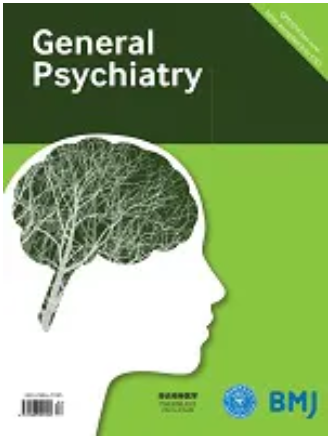Systemic low-grade inflammation associated with specific depressive symptoms: insights from network analyses of five independent NHANES samples
IF 6.8
3区 医学
Q1 PSYCHIATRY
引用次数: 0
Abstract
To the editor: Major depressive disorder (MDD) is a heterogeneous disorder with varying symptom presentations and underlying biological mechanisms.1 The mainstream neurobiological hypotheses of depression involve monoamine neurotransmitters, hypothalamic–pituitary–adrenal axis, immune-inflammation and the glutamate system.1 Numerous meta-analyses have reported that patients with MDD have a higher level of peripheral and cerebrospinal inflammatory markers, including C- reactive protein (CRP), interleukin 1beta (IL-1β), IL-6 and tumour necrosis factor-alpha (TNF-α).2 3 CRP, as an acute marker of reactant, is the most well-studied biomarker of MDD; numerous investigations revealed that elevated CRP was linked to core symptoms of MDD, including increased depressive mood4 and greater anhedonia.5 Several studies also have discovered links between CRP and cognitive symptoms (eg, difficulty concentrating)6 and suicidal behaviours.7 Moreover, CRP is more commonly reported in association with neurovegetative symptoms, including fatigue or loss of energy, changes in appetite and sleep problems.6 The association between CRP and specific symptoms remains unknown; uncovering specific symptoms driven by CRP could help identify the possible inflammatory subtypes of depression to pave the way for more specific anti-inflammatory treatments. The data for this secondary analysis was derived from five National Health and Nutrition Examination Survey (NHANES) samples (2005–2006, 2007–2008, 2009–2010, 2015–2016 and 2017–2020). NHANES encompasses nationally representative community samples within the USA, and the surveys are designed to examine the nutritional status and physical and mental health. NHANES has been conducting ongoing 2-year cycles of surveys of a representative, stratified, multistage probability sample of the US population since 1999. Each wave of surveys recruits a different set of participants. Those who were chosen and consented to participate completed a computer-assisted interview done in their homes by trained staff. Following the home interview, all tests (including the blood draw) and additional interviews (including the assessment of depressive …与特定抑郁症状相关的全身性低度炎症:从五个独立的 NHANES 样本网络分析中获得的启示
致编辑:1 抑郁症的主流神经生物学假说涉及单胺神经递质、下丘脑-垂体-肾上腺轴、免疫炎症和谷氨酸系统。大量荟萃分析表明,多发性抑郁症患者的外周和脑脊液炎症标志物水平较高,包括 C 反应蛋白(CRP)、白细胞介素 1β(IL-1β)、IL-6 和肿瘤坏死因子-α(TNF-α)。2 3 CRP 作为一种急性反应物标志物,是研究得最多的 MDD 生物标志物;大量调查显示,CRP 升高与 MDD 的核心症状有关,包括抑郁情绪增加4 和失乐症加重5。6 CRP 与特定症状之间的关系仍不清楚;发现 CRP 导致的特定症状有助于确定抑郁症可能的炎症亚型,从而为更有针对性的抗炎治疗铺平道路。这项二次分析的数据来自五次全国健康与营养调查(NHANES)样本(2005-2006年、2007-2008年、2009-2010年、2015-2016年和2017-2020年)。NHANES 包括美国国内具有全国代表性的社区样本,调查旨在考察营养状况和身心健康。自 1999 年以来,NHANES 对美国人口中具有代表性的分层多阶段概率样本进行了持续的两年一周期的调查。每一波调查都会招募一组不同的参与者。被选中并同意参与的人在家中完成由训练有素的工作人员进行的计算机辅助访谈。在家庭访谈之后,所有的测试(包括抽血)和附加访谈(包括抑郁评估)都将进行。
本文章由计算机程序翻译,如有差异,请以英文原文为准。
求助全文
约1分钟内获得全文
求助全文
来源期刊

General Psychiatry
医学-精神病学
CiteScore
21.90
自引率
2.50%
发文量
848
期刊介绍:
General Psychiatry (GPSYCH), an open-access journal established in 1959, has been a pioneer in disseminating leading psychiatry research. Addressing a global audience of psychiatrists and mental health professionals, the journal covers diverse topics and publishes original research, systematic reviews, meta-analyses, forums on topical issues, case reports, research methods in psychiatry, and a distinctive section on 'Biostatistics in Psychiatry'. The scope includes original articles on basic research, clinical research, community-based studies, and ecological studies, encompassing a broad spectrum of psychiatric interests.
 求助内容:
求助内容: 应助结果提醒方式:
应助结果提醒方式:


